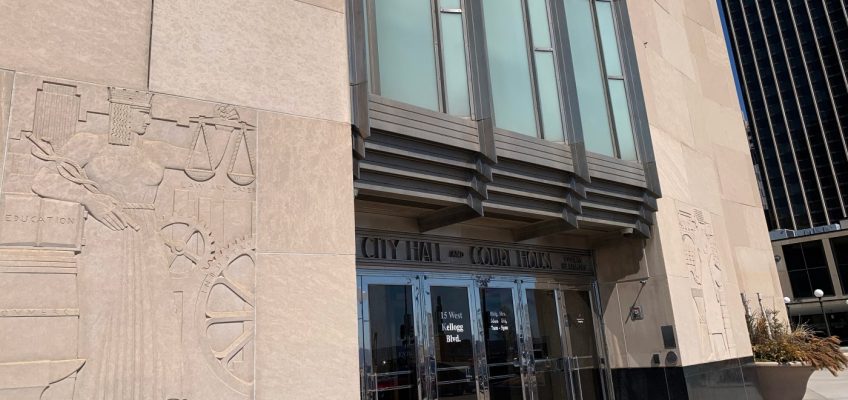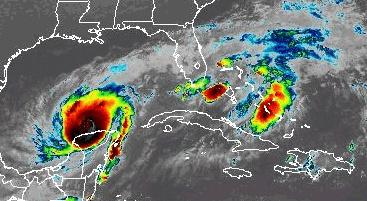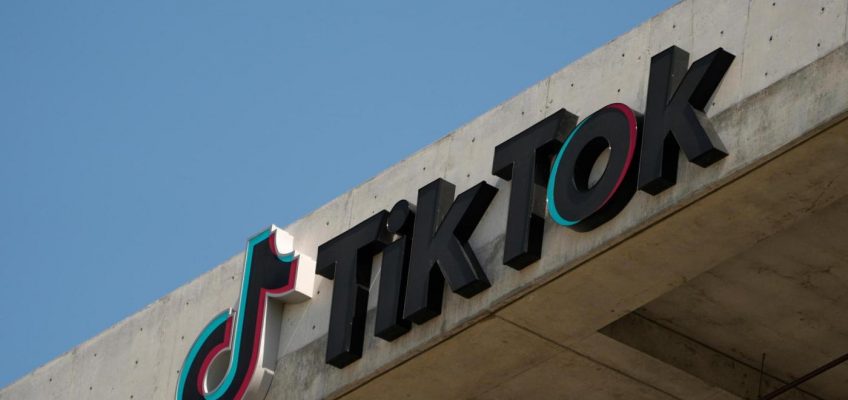Residents along Florida’s Gulf coast near Tampa Bay are being urged to complete their storm preparations today — or evacuate if necessary — as Hurricane Milton barrels toward the state with “the potential to be one of the most destructive hurricanes on record” for Florida within 36 hours, National Hurricane Center forecasters said.
Overnight, Milton went through an eyewall replacement in the Gulf of Mexico, something which typically happens in large hurricanes and results in the storm’s wind field expanding and its power dropping. Just prior to the replacement, Milton had intensified at an astonishing rate and barometric pressure had plunged below 900 millibars, making it one of the top five most intense Atlantic hurricanes on record.
Top sustained winds as of 11 a.m. Monday morning were 150 mph, still a catastrophic Category 4 but down from the Monday night peak of 180. Forecasters said Milton’s intensity may continue to fluctuate up or down over the Gulf of Mexico’s deep, warm waters.
The exact forecast track remains in flux. As of Tuesday morning, landfall is forecast to be just south of Tampa Bay, but the cone of uncertainty stretches from the Gulf Hammock Wildlife park south to Captiva Island. A direct or near-direct hit on Tampa Bay could bring storm surge of 12-15 feet. The mayor of Tampa told residents that such a surge would be “unsurvivable” to those who ignore evacuation orders.
After landfall, the forecast shows Milton tracking parallel to Interstate 4, passing just south of Orlando, and exiting the state’s Space Coast. Regardless of where the storm hits directly, Milton will have a very large wind field by landfall and much of the central portion of Florida is at risk of flash flooding, destructive wind and possible tornadoes.
As of 11 a.m., Hurricane Milton was located about 520 miles west-southwest of Tampa, moving east-northeast at 9 mph. Hurricane-force winds extend outward up to 30 miles from the center, and tropical-storm-force winds extend outward up to 105 miles from the center.
Tampa Bay has not endured a direct hit from a hurricane in more than a century. If the track holds and Milton remains a major hurricane, the storm surge in the region would be catastrophic, forecasters said.
Here’s the forecast track for Hurricane Milton as of 8 a.m. Tuesday (National Hurricane Center)
Forecasters said that although the eyewall replacement that occurred overnight had weakened Milton slightly, that’s not exactly good news. “The eyewall replacement cycle will likely lead to an expansion of the destructive inner core of the hurricane during the next day or two,” the hurricane center said.
Hurricane warnings extend far inland as Milton is forecast to retain hurricane strength during its entire passage east across Central Florida and Orlando, then out into the Atlantic Ocean near Cape Canaveral. South Florida is under a tropical storm watch with high winds from 58 mph to 73 mph and heavy rainfall possible despite being far from Milton’s forecast path.
The Tampa Bay area is still rebounding from Helene and its powerful surge — a wall of water up to 8 feet it created even though its eye was 100 miles offshore. Twelve people died there, with the worst damage along a string of barrier islands from St. Petersburg to Clearwater.
Stragglers were a problem during Helene and 2022’s Ian. Many residents failed to heed ample warnings, saying they evacuated during previous storms only to have major surges not materialize. But there was evidence Monday that people were getting out before Milton arrives.
A steady stream of vehicles headed north toward the Florida Panhandle on Interstate 75 as residents heeded evacuation orders. Traffic clogged the southbound lanes of the highway for miles as other residents headed for the relative safety of South Florida.
“This is a ferocious hurricane,” Gov. Ron DeSantis said Monday. “Anything south of the storm is going to have major storm surge, even 100 miles away.”
“By taking an extremely unusual track across the Gulf slightly farther south than forecast, Milton has a long runway in an atmospheric environment that is forecast to be extremely conducive to strengthening,” said Fox Weather hurricane expert Bryan Norcross. “Unless we get extremely lucky, Milton will be one of the biggest hurricane disasters in history.”
DeSantis pointed out that there was loss of life due to Hurricane Helene two weeks ago, and Milton’s surge looks to be worse. The predicted storm surge is the highest ever forecast for Tampa Bay and nearly double the levels reached two weeks ago during Helene, said National Hurricane Center spokeswoman Maria Torres.
Much of Florida’s west coast is under threat of severe storm surge, with as much as 15 feet forecast for areas around Tampa Bay. (National Hurricane Center)
Many sand dunes and other natural protection were destroyed less than two weeks ago by Hurricane Helene. “That means storm surge impacts from Milton could be even more significant,” said AccuWeather chief meteorologist Jon Porter.
The hurricane center issued a multitude of watches and warnings Monday evening.
A hurricane warning has been issued for the west coast of Florida from Bonita Beach north to the mouth of the Suwannee River, including Tampa Bay.
A tropical storm warning has been issued for the west coast of Florida south of Bonita Beach to Flamingo, including Lake Okeechobee.
There is a tropical storm warning for the Florida Keys, including the Dry Tortugas. A tropical storm watch stretches from Miami-Dade to Port St. Lucie, and another for the coasts of Georgia and South Carolina. There is a hurricane watch from the St. Lucie/Indian River County Line northward to the mouth of the St. Marys River in Georgia.
A storm surge watch has been issued for the U.S. East Coast from Sebastian Inlet to Edisto Beach, South Carolina, including the St. Johns River.
The storm surge warning for the west coast also extends from Flamingo north to the Suwannee River, including Charlotte Harbor and Tampa Bay.
In South Florida, tropical-storm-force winds could arrive by by Wednesday afternoon, the National Weather Service said.
DeSantis said that while it remains to be seen just where Milton will strike, it’s clear that Florida is going to be hit hard: “I don’t think there’s any scenario where we don’t have major impacts at this point.”
The state’s Director of Emergency Management, Kevin Guthrie, said the state is preparing for the largest hurricane evacuation since 2017, when Hurricane Irma cut through the entire length of the Florida peninsula from the Keys to Georgia.
“Please, if you’re in the Tampa Bay area, you need to evacuate,” said Guthrie. “If they have called your evacuation order, I beg you, I implore you, to evacuate. Drowning deaths due to storm surge are 100% preventable if you leave. We had situations where people died drowning in Hurricane Ian. Had they just gone across the bridge, from Estero Bay and Sanibel island … they’d still be alive today.”
It’s the “black swan” worst case scenario that MIT meteorology professor Kerry Emanuel and other hurricane experts have worried about for years.
Part of it is that for some reason — experts say it’s mostly luck with a bit of geography — Tampa hasn’t been hit with a major hurricane since the deadly 1921 hurricane that had 11 feet of storm surge that inundated downtown Tampa, though there wasn’t much to the city at the time, Emanuel said. Since then, a metropolis has grown and it’s full of people who think they’ve lived through big storms when they haven’t, he said.
“It’s a huge population. It’s very exposed, very inexperienced and that’s a losing proposition,” Emanuel, who has studied hurricanes for 40 years, said. “I always thought Tampa would be the city to worry about most.”
Guthrie said that if you need assistance evacuating, you can call the state’s hotline: 800-729-3413. There’s also a website, fl511.com, for with emergency evacuation information.
State officials said that Visit Florida has emergency accommodation modules on Expedia, Priceline and Booking.com for real-time hotel availability. Uber will also be offering free rides to shelters, as they did during Hurricane Helene. DeSantis said the the state would be issuing a code for Uber shortly.
DeSantis warned that hurricane-force winds will penetrate far inland. “You’re going to have hurricane winds, potentially category 3, but certainly 1 or 2, all the way through the Florida peninsula,” he said.
The state has prepared emergency fuel sources and electric vehicle charging stations along evacuation routes, and “identified every possible location that can possibly house someone along those routes,” Guthrie said. People who live in homes built after Florida strengthened its codes in 2004, who don’t depend on constant electricity and who aren’t in evacuation zones, should probably avoid the roads, he said.
DeSantis stated that crews readying to mobilize for power restoration, and that Milton may cause outages greater than those brought by Hurricane Helene.
There is a “massive amount of resources being marshalled,” he added.
On Monday, the Biden administration approved an Emergency Declaration for Florida, allowing federal disaster assistance for the state through the Federal Emergency Management Agency.
There had been media rumors that DeSantis “declined a call” with Vice President Kamala Harris. DeSantis said that was not true, and that at the time, he didn’t know she had called. He said President Joe Biden has approved everything Florida has asked for. The president and the governor spoke Monday night, the White House said.
Milton is expected to bring rain totals of 5 to 8 inches, with localized areas seeing potentially up to 18 inches, across portions of the central to northern Florida peninsula through Thursday. That will come on top of moisture ahead of the hurricane that is already saturating the state.
“If the center of Milton tracks just to the north of Tampa Bay, the scope of potential storm surge is impossible to imagine,” Norcross wrote on his blog, Hurricane Intel. “Think of of Helene’s surge and add another few feet.”
A flood watch is in effect for all of South Florida into Thursday morning, though all three counties are not in the forecast cone as of Tuesday morning. Broward and Palm Beach county schools will be open Tuesday, but close Wednesday and Thursday, the districts announced on Monday afternoon.
Since many of the counties under the Milton state of emergency are still recovering from Hurricane Helene, DeSantis asked the Florida Division of Emergency Management and the Florida Department of Transportation to coordinate all available resources and personnel to supplement local communities as they expedite debris removal.
As many as 5,000 National Guard troops are helping state crews to remove the tons of debris left behind by Helene, DeSantis said, and he directed that Florida crews dispatched to North Carolina in Helene’s aftermath return to the state to prepare for Milton.
With Milton achieving hurricane status, this is the first time the Atlantic has had three simultaneous hurricanes after September, said Colorado State University hurricane scientist Phil Klotzbach. There have been four simultaneous hurricanes in August and September.
On Monday, the hurricane center said Milton is the third fastest-strengthening hurricane on record in the Atlantic Basin. It grew from a Category 2 on Monday morning to Category 5 by noon. Only Wilma (2005) and Felix (2007) intensified faster. Also, it grew from a tropical storm to a Category 5 hurricane within the span of 36 hours.
Rapid intensification is fueled by hot sea surface temperatures, lack of wind shear as well as the storm’s clean vertical posture. Storms with smaller diameters can more easily ramp up as well.
Other tropical systems
On Monday, a disturbance formed over the Bahamas and has 20% chance of developing in the next 2 days. It is expected to travel northeast, away from Florida.
Far in the Atlantic, Tropical Storm Leslie’s track should keep it away from land, and Kirk has become a powerful extratropical cyclone with a tracked aimed at Spain and France.
Leslie, located 1,435 miles west-northwest of Africa’s southernmost Cabo Verde Islands, had a maximum sustained wind speed of 70 mph and was moving northwest at 13 mph as of 11 a.m. Tuesday.
In addition, the National Hurricane Center is watching a tropical wave that is expected to move off the west coast of Africa in a few days, although the chance of development is low, with a 20% chance through the next seven days.
The next named storm will be Nadine.
Information from the Associated Press was used in this report.




